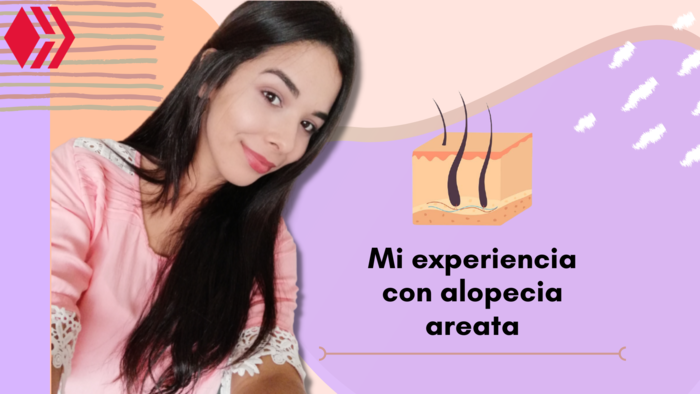
¡Hola Hiver! Espero te encuentres bien. ¿Sabes qué es la alopecia areata? Te contaré sobre ella y mi experiencia personal.
Hello Hiver! I hope you feel well, do you know what alopecia areata is? I will tell you about it and my personal experience.
¿Qué es la alopecia areata?
Es una enfermedad autoinmune caracterizada por una pérdida transitoria, no cicatrizante del cabello, con preservación del folículo piloso, ha sido considerada un proceso benigno que no pone en peligro la vida, sin embargo, debe ser manejada como una enfermedad que es capaz de tener efectos devastadores en la calidad de vida de quienes la padecen, con un impacto psicosocial importante.
What is alopecia areata?
It is an autoimmune disease characterized by a transitory, non-scarring hair loss, with preservation of the hair follicle. It has been considered a benign process that does not endanger life, however, it must be managed as a disease that is capable of having devastating effects on the quality of life of those who suffer from it, with an important psychosocial impact.
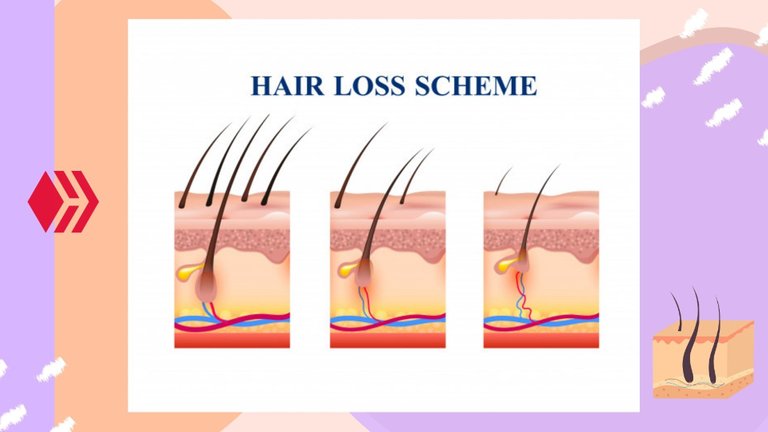
Fuente
Cuadro clínico
La lesión principal es una placa redonda u ovalada, bien delimitada, calva, lisa, de consistencia blanda, comienzo abrupto y en ocasiones eritematosa pero sin presencia de escamas.
En la mayoría de los casos las placas son asintomáticas. Cuando comienza la repoblación capilar se observa la presencia de vellos finos y despigmentados en el centro de la placa, estos recuperan gradualmente su calibre y color normal.
La localización más frecuente de la placa inicial es el cuero cabelludo (90%). Otras zonas afectadas son la barba, cejas y pestañas.
Uñas: Puede encontrarse traquioniquia (uñas asperas), onicomadesis (separación de la uña de la matriz).
Clinical picture
The main lesion is a round or oval plaque, well demarcated, bald, smooth, of soft consistency, abrupt onset and sometimes erythematous but without the presence of scales.
In most cases the plaques are asymptomatic. When capillary repopulation begins, the presence of fine depigmented hairs is observed in the center of the plaque, these gradually recover their normal caliber and color.
The most frequent location of the initial plaque is the scalp (90%). Other affected areas include the beard, eyebrows and eyelashes.
Nails: Trachyonychia (rough nails), onychomadesis (separation of the nail from the matrix) can be found.
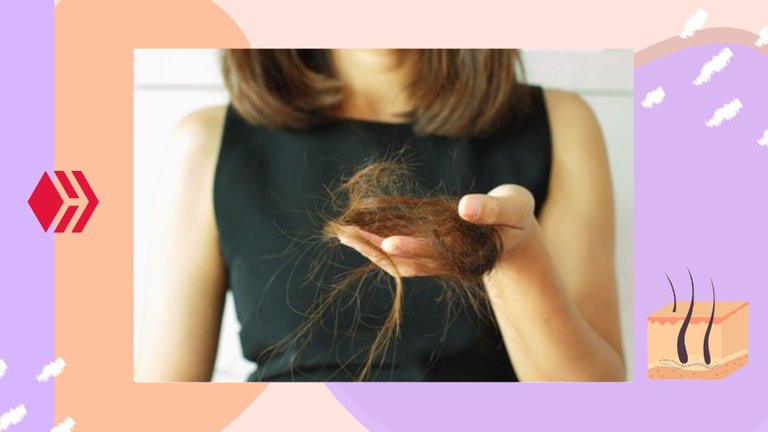
Fuente
Diagnóstico diferencial:
Sifilis secundaria, tiña del cuero cabelludo de placa blanca, tricotilomanía, alopecia por tracción, lupus eritematoso cutáneo crónico inicipiente, alopecia androgénica.
Differential diagnosis:
Secondary syphilis, tinea capitis of the scalp with white plaque, trichotillomania, traction alopecia, chronic cutaneous lupus erythematosus, androgenic alopecia.
Tipos de alopecia areata:
Alopecia areata en placa única o focal:
Es la forma más común y la de mejor pronóstico, se distingue por una placa redonda u ovalada, circunscrita y lisa. Se localiza con frecuencia en las regiones temporal, parietal o ambas, de tamaño variable, no se asocia a otras patologías. Afecta a niños y personas jóvenes.
Alopecia areata multifocal:
Se asocia a enfermedades autoinmunes y estados atópicos, afectando a jóvenes y adultos. Se presenta con placas múltiples dispersas o con tendencia a confluir y suelen extenderse a la barba, el tronco o la región púbica, evolucionando a una alopecia total o universal.
Alopecia areata total:
Existe una pérdida de más de 95% de pelo terminal del cuero cabelludo, con afectación exclusiva de éste, aunque puede comprometer a las uñas y conllevar enfermedad asociada, siendo de curso crónico con una respuesta terapéutica difícil.
Types of alopecia areata:
Single or focal plaque alopecia areata:
It is the most common form and the one with the best prognosis, it is distinguished by a round or oval, circumscribed and smooth plaque. It is frequently located in the temporal, parietal regions or both, of variable size, it is not associated with other pathologies. It affects children and young people.
Multifocal alopecia areata:
It is associated with autoimmune diseases and atopic states, affecting young people and adults. It presents with multiple plaques scattered or with a tendency to confluence and usually extend to the beard, trunk or pubic region, evolving to a total or universal alopecia.
Total alopecia areata:
There is a loss of more than 95% of terminal scalp hair, with exclusive involvement of the scalp, although it can involve nails and associated disease, being of chronic course with a difficult therapeutic response.
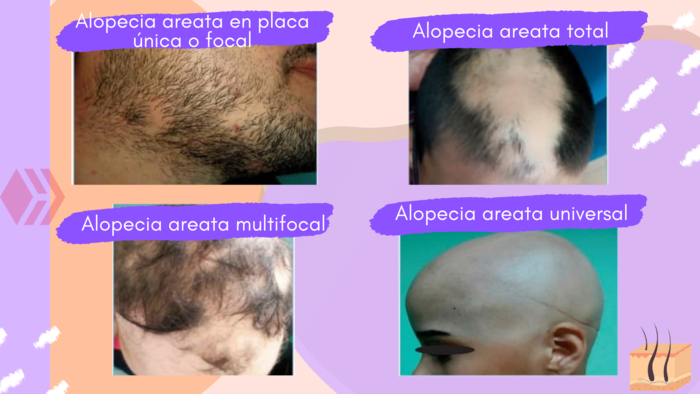
Fuente
Diagnóstico:
En la mayoría de los casos el diagnóstico es clínico, basado en un interrogatorio que revele la evolución de las lesiones y presencia de factores desencadenantes o enfermedades sistémicas, acompañado de un examen físico orientado a ubicar las lesiones principales.
Diagnosis:
In most cases the diagnosis is clinical, based on an interrogation that reveals the evolution of the lesions and the presence of triggering factors or systemic diseases, accompanied by a physical examination aimed at locating the main lesions.
Tratamiento:
Se recomienda la implementación de medidas terapéuticas precoces con el fin de evitar la progresión de la patología. Hasta el momento no existe un tratamiento de elección que cure la alopecia areata. Sin embargo, hay estudios que demuestran que la administración de algunos productos da resultados alentadores, recordando que es importante evitar la automedicación y acudir al dermatólogo, éste será el más capacitado para determinar el tratamiento adecuado en cada paciente.
Treatment:
The implementation of early therapeutic measures is recommended in order to prevent the progression of the pathology. So far there is no treatment of choice to cure alopecia areata. However, there are studies that show that the administration of some products gives encouraging results, remembering that it is important to avoid self-medication and go to the dermatologist, who will be the best qualified to determine the appropriate treatment for each patient.
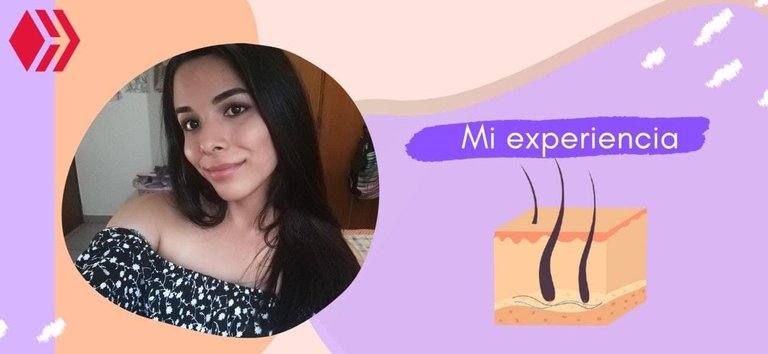
Foto de mi galeria personal, editada en canva.
Todo comenzó en el 2015, finalizando semestre en la universidad. Mi cabello siempre ha sido abundante, nunca me preocupaba si se caía un poco, ya que seguía creciendo.
Esa tarde mientras conversaba con mi mamá, ella notó que me faltaba cabello en una zona especifica, no una pérdida grande pero si significativa, así que decidí solicitar una cita con el dermatólogo.
Mientras esperaba el día, mi cabello seguía cayendose, esta vez si lo notaba. A pesar que estudio medicina en ese momento estaba cursando los primeros semestres de la carrera y no tenia mucha información sobre ese tema; sin embargo, me propuse investigar al respecto.
It all started in 2015, at the end of my college semester. My hair has always been abundant, I never worried if it fell out a little, since it kept growing.
That afternoon while talking to my mom, she noticed that I was missing hair in a specific area, not a big loss but significant, so I decided to make an appointment with the dermatologist.
While waiting for the day, my hair continued to fall out, this time I really noticed it. Although I was studying medicine at that time I was in the first semesters of my career and I did not have much information on the subject; however, I decided to investigate about it.
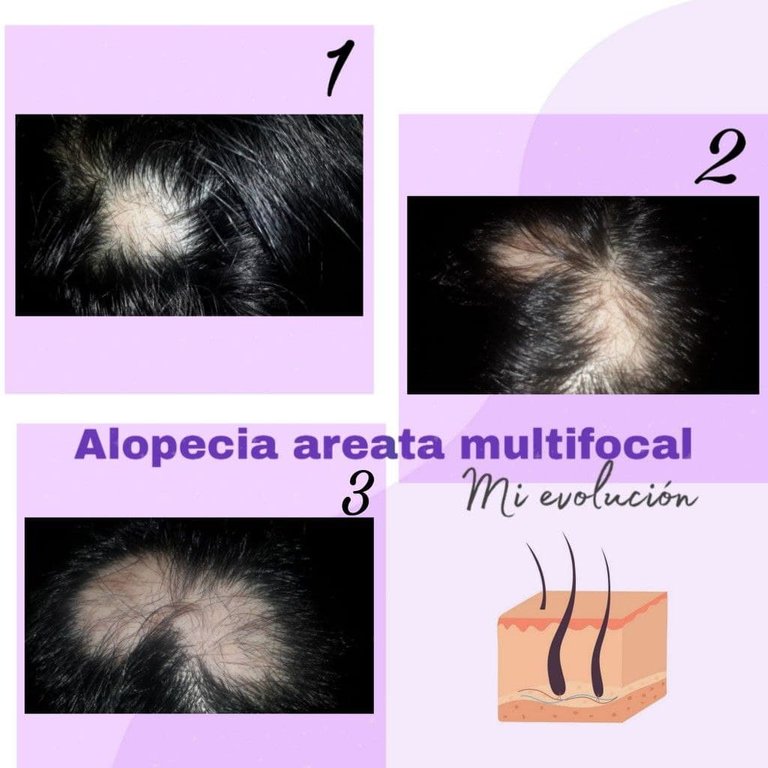
Foto de mi galeria personal, editada en canva.
Entre varios articulos, noté cierta similitud con alopecia areata, debido a que mi pérdida de cabello era localizada, mas no difusa. Efectivamente, el dermatólogo me confirmó que se trataba de alopecia areata multifocal, me solicitó exámenes de laboratorio para descartar hipotiroidismo.
Los resultados de mis exámenes estaban entre los rangos normales, por lo tanto él determinó que la causa era estrés. Me indicó tratamiento tópico y aplicó una inyeccion intralesional para acelerar el crecimiento de mi cabello.
Among several articles, I noticed a certain similarity with alopecia areata, because my hair loss was localized, but not diffuse. Indeed, the dermatologist confirmed that it was multifocal alopecia areata, he asked me for lab tests to rule out hypothyroidism.
The results of my tests were within the normal range, so he determined that the cause was stress. He indicated topical treatment and gave me an intralesional injection to accelerate my hair growth.
El proceso fue lento, demoré 1 año aproximadamente en recuperarme, hoy en día solo me quedan algunos vestigios de mi alopecia areata (cabello blanco y gris en el sitio donde tuve la mayor pérdida).
Sin duda esta patología tiene un componente psicológico importante, agradezco el apoyo de mi familia y amigos, a pesar que el proceso fue lento estaba feliz de notar el crecimento diario de mi cabello. (Sí, recuerdo que casi todos los dias me tomaba fotos para observar su evolución).
The process was slow, it took me about 1 year to recover, today I only have some traces of my alopecia areata (white and gray hair in the place where I had the greatest loss).
Undoubtedly this pathology has an important psychological component, I am grateful for the support of my family and friends, although the process was slow I was happy to notice the daily growth of my hair (Yes, I remember that almost every day I took pictures to observe its evolution).
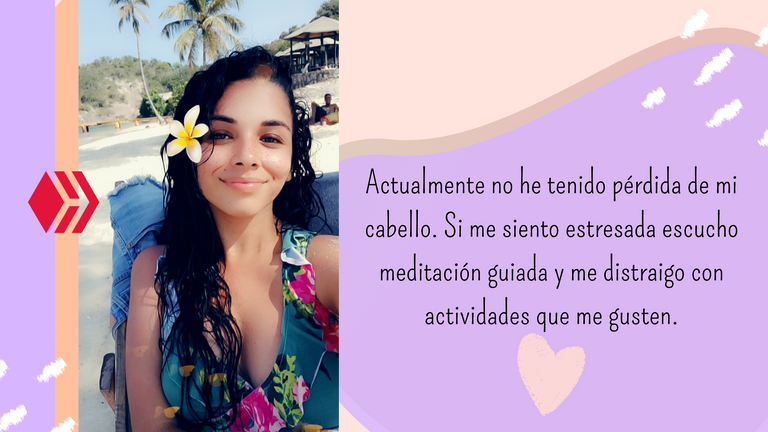
Foto de mi galeria personal, editada en canva.
Si estás pasando por una situación parecida, no te automediques ni entres en pánico, recuerda que el estrés ante estas situaciones no soluciona el problema. Busca ayuda médica, ten paciencia, te aseguro que todo mejorará. Si tienes un amigo o familiar que esté pasando por esto, bríndale todo tu apoyo, sin duda esto será una gran ayuda emocional.
If you are going through a similar situation, do not self-medicate or panic, remember that stress in these situations does not solve the problem. Seek medical help, be patient, I assure you that everything will get better. If you have a friend or relative who is going through this, give them all your support, this will undoubtedly be a great emotional help.
Espero tengas un lindo día, nos leemos en un próximo post.
Hope you have a nice day, see you in a future post.

Fuente 1: Alopecia areata: revista dermatología venezolana Vol 16 Nro 1 (2018)
Fuente 2: Dermatología - Fitzpatrick, quinta edición.
Imágenes editadas en Canva
Traducido en DeepL.com
Excelente información, aprendí mucho! me alegro por tu recuperación.
¡Gracias por leerme Alfinger! Espero te encuentres bien, saludos.
Su post ha sido valorado por @ramonycajal
Gracias por su voto, que tenga feliz día. 🤗
Congratulations @yoselyncampos! You have completed the following achievement on the Hive blockchain and have been rewarded with new badge(s) :
Your next target is to reach 800 upvotes.
You can view your badges on your board and compare yourself to others in the Ranking
If you no longer want to receive notifications, reply to this comment with the word
STOPCheck out the last post from @hivebuzz:
Support the HiveBuzz project. Vote for our proposal!
Wow! que gran post querida amiga.
Gracias por leerlo Juan, es una experiencia que me llena de motivación, ganas de seguir adelante y buscar soluciones cuando el estrés se aparece por ahí. 🙌